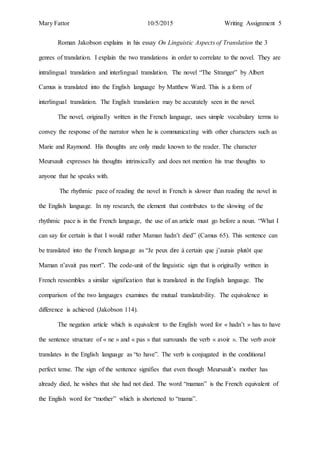
writing assignment 5
- 1. Mary Fattor 10/5/2015 Writing Assignment 5 Roman Jakobson explains in his essay On Linguistic Aspects of Translation the 3 genres of translation. I explain the two translations in order to correlate to the novel. They are intralingual translation and interlingual translation. The novel “The Stranger” by Albert Camus is translated into the English language by Matthew Ward. This is a form of interlingual translation. The English translation may be accurately seen in the novel. The novel, originally written in the French language, uses simple vocabulary terms to convey the response of the narrator when he is communicating with other characters such as Marie and Raymond. His thoughts are only made known to the reader. The character Meursault expresses his thoughts intrinsically and does not mention his true thoughts to anyone that he speaks with. The rhythmic pace of reading the novel in French is slower than reading the novel in the English language. In my research, the element that contributes to the slowing of the rhythmic pace is in the French language, the use of an article must go before a noun. “What I can say for certain is that I would rather Maman hadn’t died” (Camus 65). This sentence can be translated into the French language as “Je peux dire à certain que j’aurais plutôt que Maman n’avait pas mort”. The code-unit of the linguistic sign that is originally written in French ressembles a similar signification that is translated in the English language. The comparison of the two languages examines the mutual translatability. The equivalence in difference is achieved (Jakobson 114). The negation article which is equivalent to the English word for « hadn’t » has to have the sentence structure of « ne » and « pas » that surrounds the verb « avoir ». The verb avoir translates in the English language as “to have”. The verb is conjugated in the conditional perfect tense. The sign of the sentence signifies that even though Meursault’s mother has already died, he wishes that she had not died. The word “maman” is the French equivalent of the English word for “mother” which is shortened to “mama”.
- 2. Mary Fattor 10/5/2015 Writing Assignment 5 I perceive that the linguistic acquaintance of “maman” written in the English translation with the origin of word written in French gives a clue to the reader as how to decipher what country Meursault is originally from (Jakobson 113). The lexical code of the English language identifies “Maman” as “mother” or “mama”. The addition of the letter “n” does not confuse the reader because the English word “mama” is already encoded in the French word for “mama”. The signifier gives meaning to the attribute of “nurturing” or as the person who cared for Meursault as he was growing up. The rewording of the word “mama” changes to “maman” is intralingual translation because it is an interpretation for the English speakers who hear the utterance of “mama” in the French word. It is an exception to the rule that there is no full equivalence between code- units (Jakobson 114). I chose the example to explain the cognitive experience and classification which is understood in any existing language (Jakobson 115). The grammatical pattern of a message given in the English language cannot be translated word for word in the French language (Jakobson 116). The verbal usage of the phrase “with a punch” on page 32 in the novel The Stranger does not have the same connotative meaning as it does in the French language. “He wanted to write her a letter, “one with a punch and also some things in it to make her sorry for what she’s done””. Instead, the limited context of French vocabulary words must be used. The English slang phrase “with a punch” would have to be translated into a poetic manner that is equivalent to the phrase “a message that will evoke pity” in the French language. In conclusion the message to get across to the readers in both languages has to relate to the reader’s cognitive experiences as well as the verbal code that can be understood in each language. Although the length of the word usage may change in the process of having the written language to be translated effectively, the translation itself remains faithful to the message that is expressed in the novel.
- 3. Mary Fattor 10/5/2015 Writing Assignment 5 Bibliography Camus, Albert. The Stranger. (pg. 65) Trans. Matthew Ward. New York. Random House Inc. 1988. Print. Jakobson, Roman. "On linguistic aspects of translation." On translation 3 (1959): 30- 39.